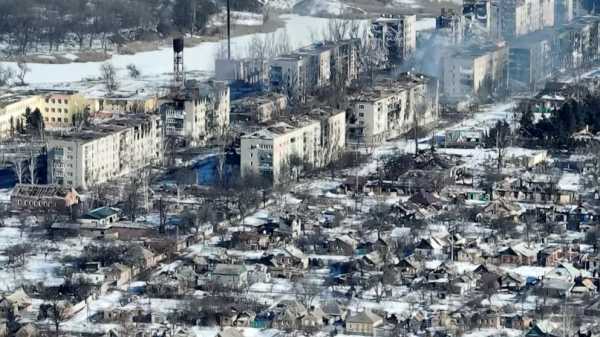
BAKHMUT, Ukraine — Amid the smoking ruins, a lone dog pads in the snow, surely unaware — or perhaps too hungry to care — that death rains down regularly from the skies on the remnants of this Ukrainian city that Russia is pounding into rubble.
But for now Bakhmut stands — growing as a symbol of Ukrainian resistance with each additional day that its defenders hold out against Russia's relentless shelling and waves of Russian troops taking heavy casualties in a months-long but so far futile campaign to capture it.
New video footage of Bakhmut shot from the air with a drone for The Associated Press shows how the longest battle of the year-long Russian invasion has turned the city of salt and gypsum mines in eastern Ukraine into a ghost town, its jagged destruction testament to the folly of war.
The footage — shot Feb. 13 — shows no people. But they are still there — somewhere, out of sight, in basements and defensive strongholds, trying to survive. Of the prewar population of 80,000, a few thousand residents have refused or been unable to evacuate. The size of the garrison that Ukraine has stationed in the city is kept secret.
Tire tracks on the roads and footprints on the paths covered with snow speak to a continued human presence. In one shot, a car drives swiftly away in the distance. Graffiti spray-painted on the charred, pockmarked outer walls of a blown-out storefront also show people are or were here.
“Bakhmut loves Ukraine,” it reads. Next to that is the stenciled face of Valerii Zaluzhnyi, the commander-in-chief of Ukraine’s armed forces, holding up two fingers in a V-for-victory gesture. "God and Valerii Zaluzhnyi are with us,” reads writing underneath.
A top Ukrainian intelligence official this week likened the fight for Bakhmut to Ukraine's dogged defense of Mariupol earlier in the war, which tied up Russian forces for months, preventing the Kremlin from deploying them elsewhere.
Likewise, "Bakhmut is also an indicator and a fortress," the official, Vadym Skibitskyi, said in an AP interview. He said the city has come to represent “the indomitability of our soldiers” and that by holding it, Ukraine is inflicting “unacceptable” casualties on the Russians.
From the air, the scale of destruction becomes plain to see. Entire rows of apartment buildings have been gutted, just the outer walls left standing and the roofs and interior floors gone, exposing the ruins’ innards to the snow and winter frost — and the drone’s prying eye.
Like a caver descending into a chasm, the drone drops slowly into one of the blown-out hulks — all four of its floors now collapsed into a pile of ashes, rubble and rusting metal at the bottom.
Another five-story apartment building has a giant bite torn out of it. A black crow flies through the gap. The drone peers into a kitchen, a once-intimate family place now exposed because one of its outer walls has been torn away. There is still a strainer in the sink and plates on the drying rack above, as though someone still lives there. But the undisturbed dusting of snow on the cloth-covered table suggests they are long gone.
As the drone continues its journey, along streets where crowds no longer walk and past stores where they no longer shop, over parks where children no longer play and where old-timers no longer chew the fat, the names of towns and cities flattened in previous wars spring to mind.
Fleury-devant-Douaumont, France — a village razed in World War I, changing hands 16 times in fighting between French and German troops from June to August 1916. Never rebuilt, it was later declared to have “Died for France” — along with eight other villages destroyed in the fearsome battle for the French town of Verdun.
Or Oradour-sur-Glane, also in France, destroyed in World War II. Its ruins have been left untouched as a memorial to 642 people killed there on June 10, 1944. Nazi troops from the fanatical SS “Das Reich” division herded civilians into barns and a church and torched the village — the biggest civilian massacre by France's wartime occupiers.
For Ukrainians, Bakhmut also is becoming etched indelibly in the collective consciousness. Its defense is already hailed in song. The track “Bakhmut Fortress," by Ukrainian band Antytila, has racked up more than 3.8 million views.
“Mom, I'm standing,” they sing. “Motherland, I'm fighting.”
In other developments Thursday:
— The Moldovan government appealed for calm and urged the public to follow only “official and credible” sources of news after Russia alleged Ukraine is planning an “armed provocation” in Moldova’s Moscow-backed breakaway region of Transnistria. Russia maintains about 1,500 “peacekeeping” troops in the region, which is internationally recognized as part of Moldova.
Shortly before the Russian Defense Ministry’s claim, an adviser to Ukraine’s Ministry of Internal Affairs, Anton Herashchenko, said Ukraine and NATO could together return Transnistria to Moldova within 24 hours.
Ukrainian President Volodymyr Zelenskyy has previously stated that Ukraine is ready to provide all necessary assistance to Moldova.
Moscow alleged, citing intelligence data without presenting any evidence, that Ukrainian soldiers disguised as Russian troops planned to launch a false flag attack to blame Russia for invading Ukraine from Transnistria that Kyiv would then use as a pretext for an invasion of the territory.
Late Thursday, the Russian Defense Ministry issued another warning of what it described as an impending Ukrainian “provocation,” reporting a massive Ukrainian military buildup near Transnistria including artillery in positions ready for combat.
“The Russian armed forces will adequately respond to the provocation planned by the Ukrainian side,” the ministry said.
— Russian President Vladimir Putin gave another signal he is digging in for a protracted war, saying his government will prioritize strengthening Russia’s defense capabilities. Speaking on Defender of the Fatherland Day, a public holiday, he announced the deployment of the Sarmat intercontinental ballistic missile system and the delivery of a massive supply of Zircon sea-launched hypersonic missiles to Russian forces. He added that three Borei-class nuclear submarines would be added to the fleet in the coming years.
— The U.N. General Assembly approved a nonbinding resolution Thursday urging Russia to end hostilities in Ukraine and to withdraw its forces.
— At least three civilians were killed and eight others were wounded in Ukraine over the past 24 hours, the presidential office reported. Russian forces over the past day launched more than 80 artillery barrages of six towns and villages in northeastern Ukraine’s Sumy region, which borders Russia, local Ukrainian authorities reported. Ukrainian forces also repelled about 90 Russian attacks in the country’s east, where fierce fighting has raged for months, the Ukrainian military said.
___
John Leicester and Hanna Arhirova contributed to this report from Kyiv.
___
Follow AP’s coverage of the war in Ukraine: https://apnews.com/hub/russia-ukraine
Sourse: abcnews.go.com






